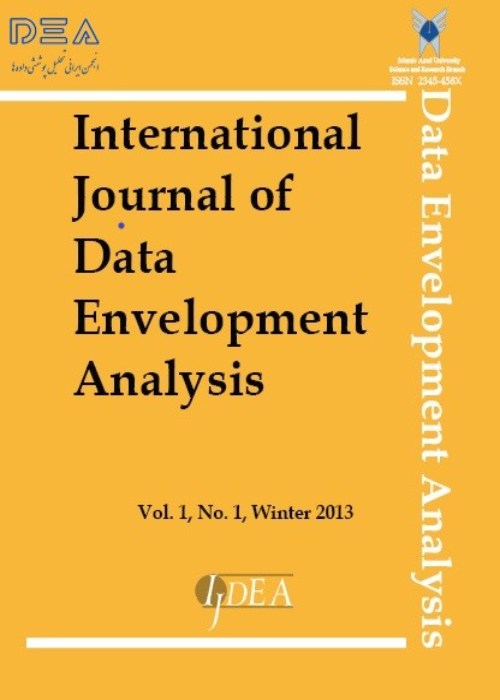فهرست مطالب
International Journal of Data Envelopment Analysis
Volume:3 Issue: 1, Jan 2015
- تاریخ انتشار: 1393/10/27
- تعداد عناوین: 6
-
Pages 575-592
In this paper, a new revenue efficiency data envelopment analysis (RE-DEA) approach is considered for finding the most revenue efficient unit with price uncertainty in both optimistic and pessimistic perspectives. The optimistic and pessimistic perspectives use efficient frontier and inefficient frontier, respectively. An integrated model is introduced to find decision making units (DMUs) that can be a candidate for most revenue efficient unit, in both optimistic and pessimistic points. Consequently, the revenue efficiency of all DMUs is calculated with by solving one model. Then a mix integer programming (MIP) model is proposed for finding the most revenue efficient DMU with common set of weights. The proposed model ensures that just one unit has been revenue efficiency. To illustrate the applicability of the new approach, the model is utilized for data from 21 medical centers in Taiwan.
Keywords: Revenue efficiency, Price Uncertainty, Decision Making Unit, Common set of weights -
Pages 593-607
Data Envelopment Analysis (DEA) is a nonparametric tool for discriminating the best performers from a number of homogenous Decision Making Units (DMU). Cost oriented DEA models identify those best DMUs which run cost efficient process. This paper validates the outcome derived from the Ideal Frontier (mentioned in Sarkar. S (2014)) derived from non-central Principal Component Analysis and a slack based optimization model to identify the cost efficient DMUs. Instead of offering real cost of each resource, the proposed model minimizes the projection of inputs along the direction of first Eigenvector of specific covariance matrix from each allocated outputs. These essential directions vectors represent various "combined consumption (cost)" for the production of outputs. A Multi-Objective Fuzzy Goal Programming model is applied here to solve this multi-objective problem. Superiority is judged on the basis of higher value of a cost oriented performance ratio. A case study of six schools is incorporated here to identify the superior cost efficient school and also to visualize gaps in their performances.
Keywords: Data Envelopment Analysis, non-central Principal Component Analysis, Non-Stochastic DEA, Frontier Function -
Pages 609-616
In the process of production, some of the inputs are fixed and cannot easily be changed, such as work hours of workers and hours of administrative or work, these types of inputs are fixed and others are variables. In this paper, by considering some inputs or outputs which are limited, their amounts must be integrated; this concept for integer data is extended. We show the importance of subject by bringing a real example of 25 branches of a bank.
Keywords: Data Envelopment Analysis, integer data, Capacity Utilization -
Pages 617-626
On account of the existence of uncertainty, DEA occasionally faces the situation of imprecise data, especially when a set of DMUs include missing data, ordinal data, interval data, stochastic data, or fuzzy data. Therefore, how to evaluate the efficiency of a set of DMUs in interval environments is a problem worth studying. In this paper, we discussed the new method for evaluation and ranking interval data with stochastic bounds. The approach is exemplified by numerical examples.
Keywords: Data envelopment analysis (DEA), Decision making unit (DMU), Efficiency, Ranking, Interval data, stochastic bounds -
Pages 627-632
the method for measuring the congestion of Noura et al. [A.A. Noura, F. Hosseinzadeh Lotfi, G.R. Jahanshahloo, S. Fanati Rashidi, R.P. Barnett, A new method for measuring congestion in data envelopment analysis, Socio-Economic Planning Sciences, 44 (2010) 240-246] ,there is no problem for congestion detection In the case of one input and one output but in higher space is not able to detect congestion of some units. we offer modification of the method of measuring the congestion of Noura et al. The proposed method ability congestion units go up and this method detect all congestion units.
Keywords: Data Envelopment Analysis, Congestion, Efficiency, Decision Making Unit -
Pages 633-651
The present study is an attempt toward evaluating the performance of portfolios and asset selectionusing cross-efficiency evaluation. Cross-efficiency evaluation is an effective way of ranking decisionmaking units (DMUs) in data envelopment analysis (DEA). Conventional DEA models assume nonnegativevalues for inputs and outputs. However, we know that unlike return and skewness, varianceis the only variable in the model that takes non-negative values. This paper focuses on the evaluationprocess of the efficiencies in the cross-efficiency matrix with negative data and proposes the use ofordered weighted averaging (OWA) operator weights for cross-efficiency evaluation. The problemconsists of choosing an optimal set of assets in order to minimize the risk and maximize return. Thismethod is illustrated by application in Iranian stock companies and extremely weights are obtainedvia OWA operator in cross efficiency for making the best portfolio. The finding could be used forconstructing the best portfolio in stock companies, in various finance organization and public andprivate sector companies.
Keywords: portfolio, Data envelopment analysis (DEA), Cross-efficiency evaluation, Negative data, Ordered Weighted Averaging (OWA) Operator


